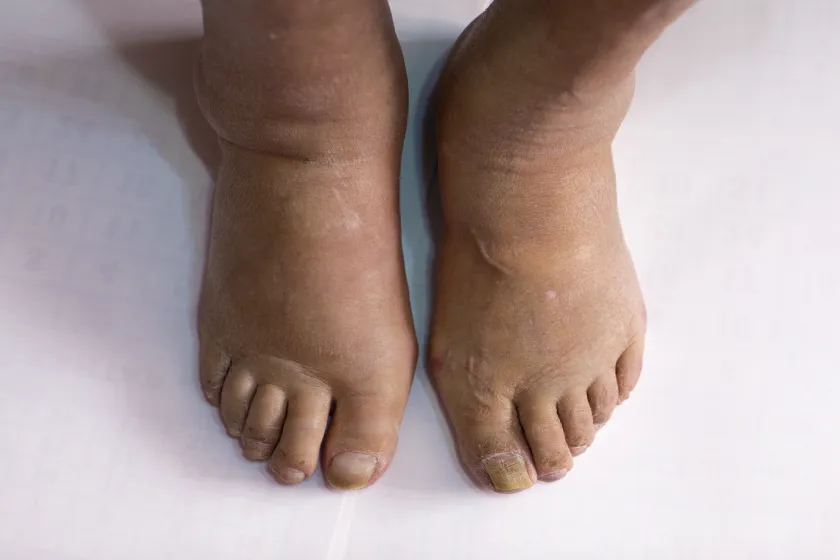
Swelling in the feet and ankles can be as harmless as temporary fluid retention, or a signal of something more serious like heart, kidney, or vascular issues. While occasional puffiness after a long day might not need medical attention, persistent or painful swelling could indicate an underlying condition that requires proper evaluation and treatment.
Swollen ankles and feet—often described medically as peripheral edema—are caused by the accumulation of fluid in the tissues. The key is to understand what’s behind the swelling so it can be addressed effectively.
Deep Vein Thrombosis, commonly known as DVT, is a serious vascular condition where a blood clot (thrombus) forms in a deep vein, usually in the legs. These clots can partially or completely block blood flow and, if dislodged, may travel to the lungs—causing a life-threatening condition called pulmonary embolism (PE).
What is Swelling in Feet and Legs?
Swelling (or edema) is a result of fluid buildup in the tissues of the lower limbs. It can affect the foot, ankle, and even the entire leg.
There are two broad categories:
- Temporary Swelling: Often due to heat, long hours of standing or sitting, mild injuries, or pregnancy.
- Persistent or Chronic Swelling: Could point to underlying medical conditions such as chronic venous insufficiency, heart failure, kidney disease, or deep vein thrombosis (DVT).
It’s important to differentiate between benign swelling and swelling that might be a symptom of a vascular or systemic problem.
10 Common Causes of Swollen Ankles and Feet
Prolonged Sitting or Standing
Staying in one position for too long restricts proper blood flow, leading to fluid accumulation. This is common in those with sedentary jobs or people who stand for extended hours.
Venous Insufficiency
When the veins in your legs are unable to efficiently return blood to the heart, blood pools in the legs. This leads to heaviness, visible varicose veins, and swelling, especially towards the end of the day.
Deep Vein Thrombosis (DVT)
A blood clot in the deep veins, often in the leg, can cause sudden swelling, pain, and a feeling of tightness. It can be life-threatening if not treated promptly and may lead to pulmonary embolism.
Heart Conditions
Heart failure can result in fluid buildup in the lower extremities. This usually presents as swelling in both feet and ankles and may be accompanied by breathlessness or fatigue.
Kidney Disease
Damaged kidneys cannot remove excess fluid properly. This can lead to swelling in the legs, ankles, and even the face, especially in the morning.
Liver Disease
Reduced liver function affects the production of proteins like albumin, leading to a leakage of fluid into tissues, including the lower limbs.
Injury or Trauma
A fracture, ligament tear, or sprain can cause localized swelling in one foot or ankle. This is usually accompanied by pain and limited mobility.
Infections
Infections like cellulitis can cause painful swelling with redness and warmth, usually affecting one leg or foot. People with diabetes are at greater risk of such infections.
Lymphatic Obstruction (Lymphedema)
When lymph fluid cannot drain properly, it builds up in the tissues, causing persistent swelling, typically in one leg. This condition may result from infections, surgery, or even cancer treatment.
Medications
Certain medications, such as calcium channel blockers, steroids, NSAIDs, or hormone therapy, may cause fluid retention and swelling in the feet and legs.
When to Seek Medical Help
You should consult a healthcare professional if:
- The swelling is sudden, painful, or one-sided.
- It’s accompanied by skin changes, ulcers, or visible veins.
- You experience shortness of breath, fatigue, or chest pain.
- The swelling persists despite rest and elevation.
Swelling linked with systemic conditions or vascular problems needs evaluation by a vascular specialist or relevant medical expert to prevent complications.
Treatment Options for Swollen Legs and Feet
Treatment depends on the underlying cause:
- For venous issues: Compression stockings, leg elevation, medications, and in some cases, surgical interventions like laser therapy or sclerotherapy.
- For DVT: Blood thinners and anticoagulation therapy under close supervision.
- For heart, kidney, or liver causes: Appropriate systemic treatment by a specialist.
- For infections: Prompt antibiotic treatment.
A detailed vascular assessment, including Doppler studies, may be required to rule out blockages or valve incompetence.
How to Reduce Leg Swelling at Home
- Elevate your legs above heart level when resting
- Avoid prolonged sitting or standing.
- Stay active with regular walking or leg movements.
- Wear compression stockings (if advised by a doctor).
- Reduce salt intake to avoid water retention.
- Stay hydrated to help the body regulate fluid balance.
Conclusion
Swollen feet and ankles might seem like a minor annoyance, but they can be the body’s way of signaling deeper health concerns. Understanding the cause of swelling is crucial for targeted treatment. If the swelling is persistent or associated with other symptoms, do not delay consulting a vascular expert. Timely diagnosis can help you prevent long-term complications and improve your overall quality of life.
Frequently Asked Questions (FAQs)
The most common cause is fluid retention due to venous insufficiency, long periods of immobility, or certain medical conditions.
Elevate your legs, reduce salt intake, and stay active. Compression stockings may also help if advised by a doctor.
Low protein (albumin) levels due to malnutrition or liver issues can cause swelling. Sometimes, low iron or vitamin B levels are also involved.
While uncommon, a severe deficiency can affect nerve and blood flow, contributing to mild swelling.
Yes, bananas are rich in potassium, which helps reduce fluid retention and balance sodium levels in the body.

Dr. Sumit Kapadia
MBBS, MS, MRCS, DNB-Fellow



